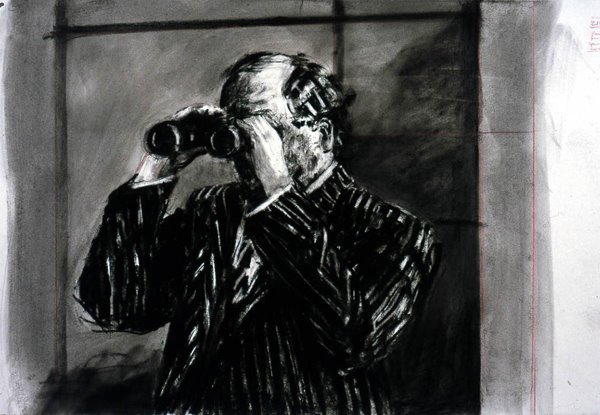
The retrospective of William Kentridge sculpture and graphic work and video opened today (a cold gray day) at the San Francisco Museum of Modern Art. Kentridge appeared on stage in a one-hour performance piece called I Am Not Me, The Horse Is Not Mine. For the performance, I secured a ticket a couple of months ago on the same day they went on sale. There is no question Kentridge is my favorite living artist. It was an hour the mind will have no trouble remembering, the hour used for the purpose of watching his elaborately staged representation of himself in the museum's small beautiful Phyllis Wattis Theater.
Below, a sampling of Kentridge works and portraits from various sources.







The sculpture immediately above is part of Kentridge's exhibition on the Museum's fourth floor, although it is supported in San Francisco by different books. And the Kentridge performance emphasized his reliance on literature and music for the vitality of his visual work. He read passages from Gogol, from Sterne's Tristram Shandy and from transcripts of the Moscow Show Trials in the course of acting out his struggles to create a new production for the Metropolitan Opera in New York (scheduled for 2010) of the 1920s Shostakovich opera, The Nose. As a South African who grew up under apartheid Kentridge has a particularly intense take on the ecstatic Russian modernism of the 1920s (as represented by Shostakovich's opera) and the way it was crushed by 1930s Stalinism. He could at the same time express the personal interior dividedness between the rational citizen and that person's unregulated imagination. Kentridge interacted with projected images of himself who appeared to be reflecting skeptically on whatever the live Kentridge was getting up to. At some points there were three Kentridges on stage, two filmed and one live. But toward the end a sudden synthesis unexpectedly occurred, the live artist up on a ladder tossing loose pages of notes down onto the stage in exasperation and the projected image of the artist easily and gracefully catching them mid-air. The mostly upper-class, mostly white, mostly aging audience (smug and vapid and loud during the long wait before the performance started) spontaneously applauded at this moment, and I suddenly felt less alienated from them.

Production design for Mozart's Magic Flute, 2005. The San Francisco exhibition includes a projection of Kentridge's long animated sequence set to the opera's overture. In the same gallery are two model theaters (seemingly knocked together out of scrap lumber, push pins and C-clamps) which suddenly leap into glowing life (at intervals) with musical/theatrical animations of their own. Kentridge is, as I said, my favorite living artist -- because there is this perceptible & confident & wide-sweeping intelligence (enhanced by technical bravado). But isn't intelligence too weak a word? Kentridge is, like William Blake, a visionary.





The William Kentridge show runs until May 31. One gallery has variations and fragments of the performance I saw today projected onto all four of its walls simultaneously.
